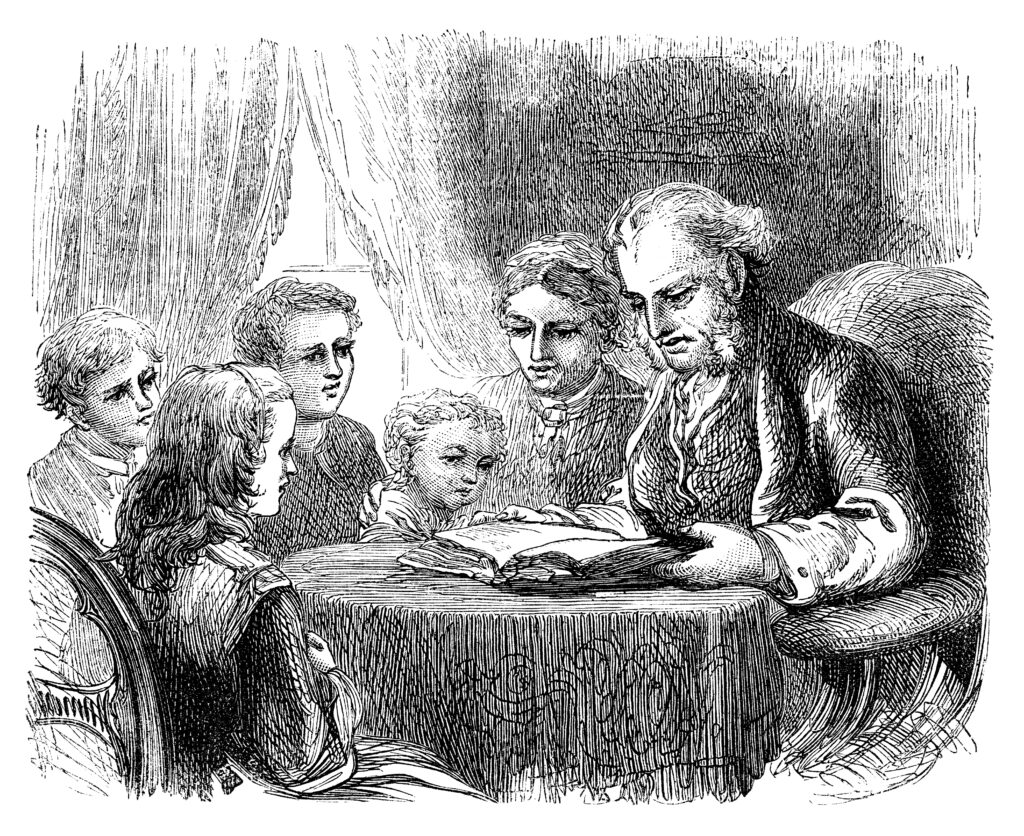If you are a father, you have a profound duty to your family to execute your God-given role. You have been given small children to train up in the way they should go (Proverbs 22:6). What a wonderful blessing! The Puritians rightly viewed the father as the “priest of the home” and viewed training his children to love and obey God as a particular calling in his family life. I aim for this brief introduction to be helpful in starting this up in your own household.
We face an enemy that seeks to devour our children, and is aggressive and emboldened by the wordly success of secular materialism. Your pastor and your (local) church are essential partners in participating in and building a community to oppose it. But your family also needs you standing at the gate, defending them from this madness and preparing them to stand boldly against it for Christ and His Kingdom. It is my view that there is perhaps no more important practice/habit here than family worship.
So what does that look like? Let me first introduce some helpful resources, and then I will describe what I do.
First, get and read Joel Beeke’s Family Worship – which you can get at Reformation Heritage Books (ahem, not Amazon). You might also consider his Family Worship Bible Guide. I’d also recommend Voddie Baucham’s Family Driven Faith as an excellent read and resource.
From these books you should get a good sense of where to begin, and what is perhaps the right set of things to focus on. Depending on the age range of your children, you may have to adjust the level you’re trying to land the content. In my case, we have a teenager all the way through toddlers and infants, so this mix is admittedly a bit of a challenge. The toddlers might not sit still and at attention for it, and that’s OK. They are listening.
With that introduction, here is how I do it: each week I plan out five days of content for the week. This allows for a missed evening without things falling off the rails – I can simply run it to Saturday if needed. We take the Lord’s day off from planned family worship.
The basic structure is as follows:
- Opening Hymn
- Opening Prayer
- Songs of Worship
- Catechism
- Scripture Teaching
- Closing Prayer
- Closing Hymn
Depending on the discussion, this typically runs about 30-45 minutes. I’ll go through each one in more detail, using examples from this week’s notes.
Opening Hymn
This is exactly what it sounds like – we open with a hymn or song. I try to rotate the songs every two weeks or so. That gives us enough time to learn them and not too long where they start to get “old.” I have a Bluetooth speaker (not Google or Amazon of course) that I connect my phone to and steam the music into the room. I try to find a good recording that we can sing along to that will help the kids. It can be kind of challenging to find good sources here, but there are out there. You could of course play guitar or piano if you are able.
I like to use hymns that illustrate gathering/assembling, or singing praises to the Lord.
This week we’re singing We Gather Together.
Opening Prayer
After the opening hymn I open with a brief prayer. Typically the focus is giving thanks and praise.
Songs of Worship
Next we sing two more songs/hymns. I think the singing is what truly makes it family “worship”, and so we sing a total of four songs together. I try to choose a songs that we sing in the assembly, so that even the younger children can learn them and participate in corporate worship with the church. It is wonderful to be in the assembly and see them get excited because they already know the song we are singing next.
This week we’re singing Praise The Lord (Psalm 150) and There Is A Higher Throne.
Catechism
Each day we go through one catechism question and discuss it. I am using the Westminster Shorter Catechism in Modern English, from https://matt2819.com/. I find the commentary added to be helpful in explaining and discussing the doctrine.
I cannot stress the importance of this enough – we are beset on all sides by wolves and false teachers. If you do not teach your children sound doctrine, someone else will teach them unsound doctrine. Do not leave this out!
Here’s the question I’m covering today:
Question 10. How did God create man?
God created man, male and female, in his own image,[a] in knowledge,[b] righteousness, and holiness,[c] with rule over the creatures.[d]
[a]. Gen 1:27
[b]. Col 3:10
[c]. Eph 4:24
[d]. Gen 1:28; see Psa 8:1-9
Comment on Question 10. God used a pattern when he created man, and that pattern was himself, his own image! Man was made to be like God on the creaturely level. Man as created knew God, thought and acted righteously, and was pure in heart and full of love for his Maker. Man is the special creation of God. Man is made as a race – a creature reproducing itself through successive generations. It is our descent from Adam and Eve that gives us kinship by blood with all other human beings on earth (Acts 17:26).
[Note the above is taken from https://matt2819.com and I highly recommend going to his site and getting a full copy yourself.]
Scripture Teaching
Next we read and study the Word. For this, I recommend getting a copy of Logos Bible Software and a few commentaries to help guide explanation and teaching. Choose such commentaries carefully, and be wary of the interpretive assumptions that go into them. I primarily use R.C. Sproul’s Reformation Study Bible, Matthew Henry’s Concise Commentary on the Bible, and John MacArthur’s NASB Study Bible. Know the author’s views on secondary issues and avoid their commentary where you conflict. For example, when teaching Revelation I will generally not use MacArthur’s discussion.
I would suggest not trying to do too much at one time and limit the daily coverage to a few verses, or a section at most.
I’m currently teaching through Proverbs, and this week we’re covering Proverbs 21:10-24 (3 verses a day).
After the planned Scripture teaching I open it up for the children to share new verses they have memorized, or to bring verses or passages they are learning or have questions about for discussion.
Closing Prayer
After the Scripture teaching I close us in prayer. This is a prayer of thanksgiving, as well as more specific prayers for those we know and wish to pray for. I might pray for our leaders and for our enemies.
Closing Hymn
Finally we sing one more song. I try to keep this one shorter and more consistent from week to week, and make it a benediction or doxology sort of song. In fact, the Doxology probably has the home record for most sung closing song.
We’re currently singing Nearer My God To Thee.
That’s it! I’ve built this into our family routine and it is as normal and typical as eating dinner. The time spent together in worship, prayer, and reading God’s word is a joy and I can’t imagine a better way to spend the time.

